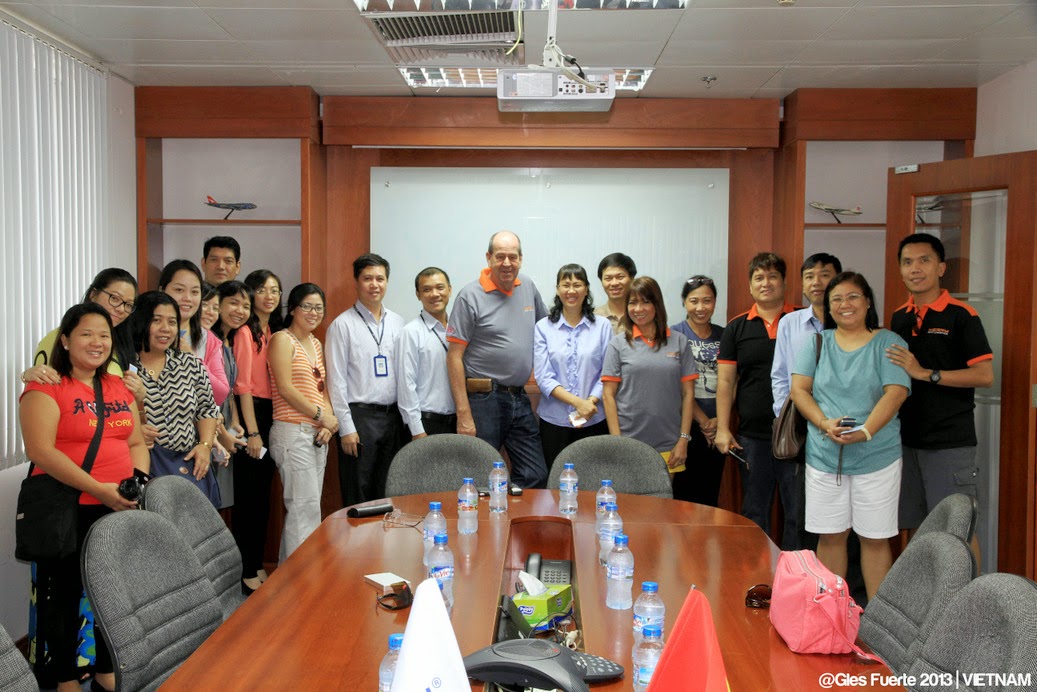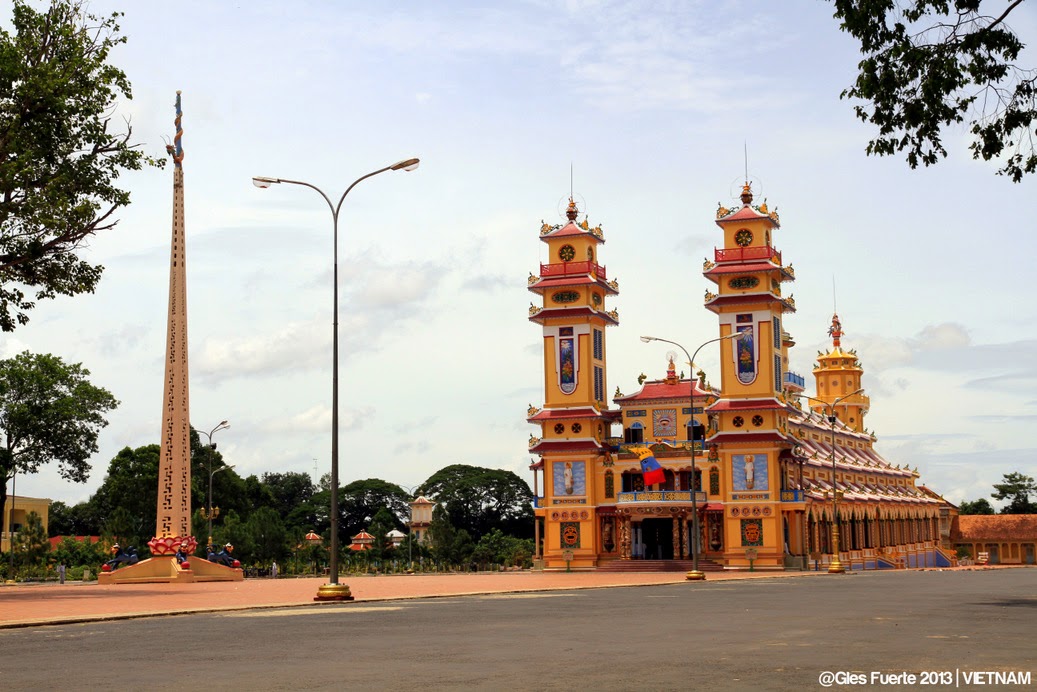Explore Cao Dai Pagoda and the Cu Chi Tunnels
We left the hotel on board our coach at 0730H to visit FDI, Kerry Logistics joint venture in Vietnam.
 |
| FDI Reception |
At 0800H, we arrived at the FDI office. We were all warmly welcomed by the management and staff of FDI. In fact, everyone was standing when we entered the office, everyone was ready to welcome us.
I have to say that the owner, Ms. Phuong Lien, was so accommodating - beyond of what I was expecting.
We had a short meeting at the boardroom with the FDI leaders and had few photo shots. We left FDI office at around 0900H to continue our Vietnam adventure.
From FDI office, we head on to Tay Ninh to visit a Pagoda. The Pagoda is the official place of worship of the followers of a religion called Cao Dai.
We reached Tay Ninh at around 1100H and the Pagoda compound was still closed at that time. The prayer and ceremony officially start at 1200H until 1300H, according to our guide.
While waiting for the Pagoda to open, we decided to take our lunch at nearby restaurant. At 1200H, we went inside the Pagoda compound to witness the ceremony.
According to Wikipedia, Cao Đài (Vietnamese: [kāːw ɗâːj] ( listen), also Caodaism or Caodaiism) is a relatively modern syncretistic, monotheistic religion, officially established
in the city of Tây Ninh, southern Vietnam in 1926. Due to its young age, it shows its syncretistic roots more than older religions. Đạo Cao Đài is the religion's shortened name; its full name is Đại Đạo Tam Kỳ Phổ Độ (Great Religion [of The] Third Period [of] Revelation [and] Salvation).
Cao means "high" and Đài means "dais" (as in a platform or altar raised above the surrounding level to give prominence to the person on it). Figuratively, it means that highest spiritual place where God reigns. Caodaiists often use the term Đức Cao Đài (Venerable Cao Đài) as the abbreviated name for God, the creator of the universe, whose full title is Cao Đài Tiên Ông Đại Bồ Tát Ma-ha-tát (translation: Cao Đài [the] Ancient Sage [and] Great Bodhisattva Mahasattva).
According to Caodaiists, the full title was purposefully chosen by God because within it are representations of the Three Teachings: Saint, Sage and Buddha. Caodaiists credit God as the religion's founder.
They believe the teachings, symbolism and organization were communicated directly from God. Even the construction of the Tây Ninh Holy See is claimed to have had divine guidance. Cao Đài's first disciples, Ngô Văn Chiêu, Cao Quỳnh Cư, Phạm Công Tắc and Cao Hoài Sang, claimed to have received direct communications from God, who gave them explicit instructions for establishing a new religion that would commence the Third Era of Religious Amnesty.
in the city of Tây Ninh, southern Vietnam in 1926. Due to its young age, it shows its syncretistic roots more than older religions. Đạo Cao Đài is the religion's shortened name; its full name is Đại Đạo Tam Kỳ Phổ Độ (Great Religion [of The] Third Period [of] Revelation [and] Salvation).
Cao means "high" and Đài means "dais" (as in a platform or altar raised above the surrounding level to give prominence to the person on it). Figuratively, it means that highest spiritual place where God reigns. Caodaiists often use the term Đức Cao Đài (Venerable Cao Đài) as the abbreviated name for God, the creator of the universe, whose full title is Cao Đài Tiên Ông Đại Bồ Tát Ma-ha-tát (translation: Cao Đài [the] Ancient Sage [and] Great Bodhisattva Mahasattva).
According to Caodaiists, the full title was purposefully chosen by God because within it are representations of the Three Teachings: Saint, Sage and Buddha. Caodaiists credit God as the religion's founder.
They believe the teachings, symbolism and organization were communicated directly from God. Even the construction of the Tây Ninh Holy See is claimed to have had divine guidance. Cao Đài's first disciples, Ngô Văn Chiêu, Cao Quỳnh Cư, Phạm Công Tắc and Cao Hoài Sang, claimed to have received direct communications from God, who gave them explicit instructions for establishing a new religion that would commence the Third Era of Religious Amnesty.
The temple is very decorative and colorful. We were only permitted to walk at the side of the temple and entered through the side door. We had to remove our slippers and shoes before entering the temple.
Inside the building, I noticed two of the front pillars with a pulpit similar to the pulpit of the old Catholic church. I personally would like to take some more pictures, but I was restricted by the temple guard. Nevertheless, we enjoyed exploring Cao Dai. From Tay Ninh, we head on to Cu Chi district.
We reached Cu Chi at around 1400H. I was so excited to finally see and explore the famous "Tunnels" of Vietnam.
The tunnels were used by Viet Cong guerrillas as hiding spots during combat, as well as serving as communication and supply routes, hospitals, food and weapon caches and living quarters for numerous guerrilla fighters. The tunnel systems were of great importance to the Viet Cong in their resistance to American forces, and helped achieve ultimate military success.
At the entrance of the tunnels we were briefed by our guide - it's all about the Vietnam war.
We were gathered inside an excavated camp. Our guide was so good at explaining everything about the Vietnam war. There was a film showing aside from the map showing the geography of those who resisted the Americans, the location of the civilians and those who were with the Americans.
Right after the briefing we started walking inside the jungle. The first tunnel that we saw was a small one - enough for a typical Vietnamese guerrilla. The cover above with dried leaves served as camouflage.
I salute the ingenuity of the Vietnamese warriors with all the deadly traps they made during the war. Those who fall into it, I'm sure, had a very painful death.
Nearby the small tunnel was a termite-hive like air vent for the tunnels below. According to our guide, during the war, the guerrillas would scatter pepper around the vent so as not to be sniffed by trained dogs.
There is also a firing range at the area. Bullets of different calibers are for sale. Before getting inside the tunnels, there was a short briefing again. There is a "short tunnel" and a "long" one.
According to the authorities at the Cu Chi, the tunnels were already enlarged from the original size for easier maneuvering inside.
I took the "long tunnel". While inside the tunnel, I remembered Corregidor tunnel where we had our duck-walk.
I had very nice experience and enjoyed the place.
---o0o---













No comments:
Post a Comment